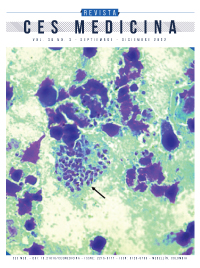Anthropometry assesment in healthy neonates. Not all measurements are relevant
DOI:
https://doi.org/10.21615/cesmedicina.6728Keywords:
neonate, anthropometry, birth weight, small for gestational age, height, head circumferenceAbstract
Anthropometric measurements are used to assess fetal and neonatal growth and determine early risk factors. Classically, weight, height, head circumference, thoracic and abdominal circumference are the usual measures. They are used to identify conditions such as low or high weight for gestational age and, based on this, to determine early and late risks. Another important measurement is head circumference, which determines neonates with potential neurological risk. These three measures are key as part of the initial neonatal evaluation, and they are also a part of the child's growth monitoring and development. However, other routine measurements such as chest and abdominal circumferences, in newborns with spontaneous adaptation and normal physical examination (healthy neonates) may provide little information about the neonatal health status. These last measurements are not part of the child growth monitoring parameters, nor do they have percentile graphs that can be extrapolated to gender and gestational age. All these measures are conditioned by multiple factors such as genetics, race, and nutrition, among others. It is time to analyze routine measures at the time of birth of healthy newborns and prioritize those that can be extrapolated to relevant clinical implications.
Downloads
References
Perez BP, Mendez MD. Routine Newborn Care. StatPearls [Internet]. Treasure Island (FL): Stat Pearls Publishing; 2022 Jan. 2021 Jul 26.
Pereira-da-Silva L. (2012) Neonatal Anthropometry: A Tool to Evaluate the Nutritional Status and Predict Early and Late Risks. In: Preedy V. (eds) Handbook of Anthropometry. Springer, New York, NY. https://doi.org/10.1007/978-1-4419-1788-1_65
Warren JB, Phillipi CA. Care of the well newborn. Pediatr Rev [Internet]. 2012;33(1):4–18. Disponible en: http://dx.doi.org/10.1542/pir.33-1-4
Cárdenas-lópez DC, Haua-navarro DK, Suverza-fernández DA. Mediciones antropométricas en el neonato. Bol Med Hosp Infant Mex, 62, May/jun 2005.
Priante E, Verlato G, Giordano G, Stocchero M, Visentin S, Mardegan V, et al. Intrauterine growth restriction: New insight from the metabolomic approach. Metabolites [Internet]. 2019;9(11):267.
Purugganan OH. Abnormalities in head size. Pediatr Rev [Internet]. 2006;27(12):473–6.
McKee-Garrett TM, Duryea RMMT. Assessment of the newborn infant. octubre-7-2021; Disponible en: https://www.uptodate.com/contents/assessment-of-the-newborn-infant/print
Azevedo IG, Holanda NSO, Arrais NMR, Santos RTG, Araujo AGF, Pereira SA. Chest circumference in full-term newborns: how can it be predicted? BMC Pediatr 2019;19(1):341.
WHO Multicentre Growth Reference Study Group. WHO child growth standards. Length, height for-age, weight-for-age, weight-for-length and body mass index-for age. Methods and development. Geneva: World Health Organization; 2006 (https://www.who.int/publications/i/item/924154693X, accessed 13 October 2014).
Villamonte-Calanche W, Pereira-Victorio CJ, Jerí-Palomino M. Antropometría neonatal a término en una población rural y urbana a 3 400 metros de altura. Rev panam salud pública. 2017;41.
Ramagopal Shastry CK, R. Bhat BP. Anthropometric measurements of newborns. Int J Contemp Pediatr. 2015 May;2(2):85-89.
Ndu IK, Ibeziako S, Obidike E, Adimora G, Edelu B, Chinawa J, Asinobi et al. Chest and occipito-frontal circumference measurements in the detection of low birth weight among Nigerian newborns of Igbo ethnicity. Ital J Pediatr. 2014 Oct 28; 40:81.
Hadush M, Berhe A and Medhanyie. Foot length, chest and head circumference measurements in detection of Low-birth-weight neonates in Mekelle, Ethiopia: a hospital based cross sectional study. BMC Pediatr. 2017 Apr 21;17(1):111.
Goto E. Meta-analysis to estimate the correlation coefficients between birthweight and other anthropometric measurements at birth. Indian J Pediatr. 2011 Mar;78(3):311-8.
Paulsen CB, Nielsen BB, Msemo OA, Møller SL, Ekmann JR, Theander TG, et al. Anthropometric measurements can identify small for gestational age newborns: a cohort study in rural Tanzania. BMC Pediatr. 2019;19(1):120.
Kang Y, Fune Wu LS, Shaikh S, Ali H, Ahmed A, Christian P, et al. Birth anthropometry predicts neonatal and infant mortality in rural Bangladesh: a focus on circumferential measurements. Am J Clin Nutr. 2022 May 1;115(5):1334-1343.
BA-Saddik IA, Al-Asbahi TO. Anthropometric measurements of singleton live full-term newborns in Aden, Yemen. Int J Pediatr Adolesc Med. 2020 Sep;7(3):121-126.
Muñoz A, Úbeda L, Caballero R, Aizpún L. Ferrández Longás A. Valores de normalidad de índice de masa corporal y perímetro abdominal en población española desde el nacimiento a los 28 años de edad. Unidad de Endocrinología Pediátrica. Hospital Infantil. 2016.
Villalobos Alcazar G, Guzman Barcenas J, Alonso de la Vega P, Ortiz Rodriguez V, Casanueva E. Evaluación antropométrica del recién nacido. Variabilidad de los observadores. Perinatol Reprod Hum 2002; 16: 74-79.
Abdel-Rahman SM, Paul Ian M, Delmore P, James L, Fearn L, Atz AM, et al. An anthropometric survey of US pre-term and full-term neonates. Ann Hum Biol. 2017 Dec;44(8):678-686.
Lemyre B, Jefferies AL and O'Flaherty P. Facilitating discharge from hospital of the healthy term infant. Paediatr Child Health. 2018 Dec;23(8):515-531.
Downloads
Published
How to Cite
Issue
Section
License
Copyright (c) 2022 CES Medicina

This work is licensed under a Creative Commons Attribution-NonCommercial-ShareAlike 4.0 International License.
Derechos de reproducción (copyright)
Cada manuscrito se acompañará de una declaración en la que se especifique que los materiales son inéditos, que no han sido publicados anteriormente en formato impreso o electrónico y que no se presentarán a ningún otro medio antes de conocer la decisión de la revista. En todo caso, cualquier publicación anterior, sea en forma impresa o electrónica, deberá darse a conocer a la redacción por escrito.
Plagios, duplicaciones totales o parciales, traduccones del original a otro idioma son de responsabilidad exclusiva de los autores el envío.
Los autores adjuntarán una declaración firmada indicando que, si el manuscrito se acepta para su publicación, los derechos de reproducción son propiedad exclusiva de la Revista CES Medicina.
Se solicita a los autores que proporcionen la información completa acerca de cualquier beca o subvención recibida de una entidad comercial u otro grupo con intereses privados, u otro organismo, para costear parcial o totalmente el trabajo en que se basa el artículo.
Los autores tienen la responsabilidad de obtener los permisos necesarios para reproducir cualquier material protegido por derechos de reproducción. El manuscrito se acompañará de la carta original que otorgue ese permiso y en ella debe especificarse con exactitud el número del cuadro o figura o el texto exacto que se citará y cómo se usará, así como la referencia bibliográfica completa.
| Article metrics | |
|---|---|
| Abstract views | |
| Galley vies | |
| PDF Views | |
| HTML views | |
| Other views | |



